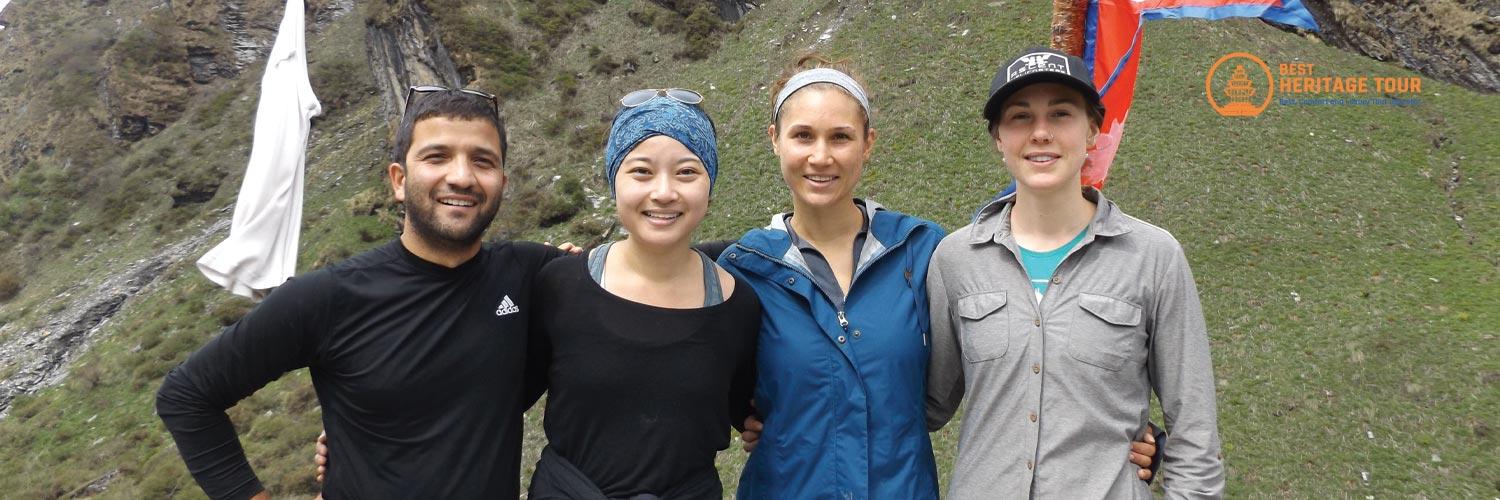Dreaming of trekking to Annapurna Base Camp but unsure if it’s too challenging? You’re not alone! Many adventurers wonder about the Annapurna Base Camp trek difficulty level before setting out on this breathtaking journey. While it’s not as extreme as the Everest Base Camp trek, it still demands endurance, stamina, and careful preparation. In this guide, we’ll break down the difficulty factors, the toughest sections of the trail, and how to train effectively for a smooth trekking experience.
How Difficult Is the Annapurna Base Camp Trek?
The Annapurna Base Camp trek is classified as a moderate trek, making it accessible for beginners with proper preparation and a rewarding challenge for experienced trekkers. On average, the trek takes 7 to 12 days, depending on your route and walking pace. Each day, trekkers typically walk 8 to 15 kilometers (5 to 9 miles), covering a range of terrains including forests, terraced fields, and steep stone staircases.
One of the most physically demanding sections is the steep ascent from Tikhedhunga to Ulleri, where trekkers must tackle over 3,000 stone steps in a single stretch. The continuous ascents and descents, especially through Chhomrong and Deurali, can be exhausting if you are not used to long hikes.
Altitude and Acclimatization Challenges
The highest point of the trek is Annapurna Base Camp at 4,130 meters (13,550 feet). Although this is not an extreme altitude, some trekkers may experience mild symptoms of altitude sickness, such as headaches, dizziness, and nausea. The body needs time to adjust to reduced oxygen levels, making proper acclimatization essential.
To minimize the risk of altitude sickness, it’s crucial to ascend gradually, stay hydrated, and take acclimatization stops at places like Chhomrong (2,170 meters/7,120 feet) and Deurali (3,230 meters/10,597 feet). If symptoms become severe, descending to a lower altitude immediately is the safest option.
Trail Conditions and Weather Challenges
The Annapurna Base Camp trail is a mix of well-paved paths, rocky sections, and dense forests. The difficulty level can vary depending on the season.
- Spring (March–May) & autumn (September–November) offer the best trekking conditions, with stable weather and clear mountain views.
- Winter trekking (December–February) is more challenging due to heavy snowfall and freezing temperatures, which can make trails slippery and difficult to navigate.
- Monsoon season (June–August) brings heavy rainfall, which makes the trails muddy and increases the risk of landslides and leeches.
Some sections, particularly near Bamboo (2,300 meters/7,546 feet) and Deurali, have narrow and slippery paths, requiring careful footing. Suspension bridge crossings also add to the adventure, making this trek both thrilling and physically demanding.
How to Train for the Annapurna Base Camp Trek
Although the Annapurna Base Camp trek does not require technical mountaineering skills, a good level of fitness is necessary. Training at least four to six weeks before the trek can significantly improve your endurance and strength.
- Cardiovascular training: Running, cycling, and swimming help build stamina for long trekking days.
- Leg strength workouts: Squats, lunges, stair climbing, and weighted hikes prepare your muscles for uphill and downhill trekking.
- Practice hikes: Walking with a loaded backpack on rough terrain simulates trekking conditions and improves endurance.
By following a proper fitness routine, you’ll be better equipped to handle the physical demands of the trek and enjoy the journey without excessive fatigue.
Tips to Overcome Annapurna Base Camp Trek Difficulties
To make your trek smoother, consider these expert tips:
- Take it slow: Avoid rushing and allow your body to adjust to the altitude gradually.
- Stay hydrated: Drink at least 3 to 4 liters of water per day to prevent altitude sickness.
- Pack wisely: Carry essential trekking gear, including lightweight but warm layers, waterproof clothing, and sturdy hiking boots.
- Use trekking poles: These provide extra stability on steep ascents and descents, making up to 50% of your weight-bearing load.
- Choose a guided trek: Local guides help with navigation, acclimatization, and cultural insights, ensuring a hassle-free experience.
Conclusion
The Annapurna Base Camp trek difficulty level is moderate, making it a manageable challenge for beginners and an exciting journey for seasoned trekkers. While the trek requires endurance and proper preparation, it does not involve technical climbing, making it one of the most rewarding Himalayan trekking experiences.
With the right training, acclimatization, and packing strategy, you can conquer this trek and immerse yourself in the stunning beauty of the Annapurna region.
Ready for the Adventure?
If you’re planning your Annapurna Base Camp trek, let Best Heritage Tour handle the logistics while you focus on the experience. From expert guides to well-planned itineraries, we ensure a safe, comfortable, and unforgettable trekking journey. Get in touch today to book your adventure!
Contact Best Heritage Tour Company
Visit Best Heritage Tour Pvt.Ltd. official website to gather information about BHT services.
Look for contact details (Phone number/Viber /What’s App: +9779851149197 / +9779810043046), Email: bestheritagetour@gmail.com/ info@bestheritagetour.com to get in touch with them directly.
Author: Best Heritage Tour
Date: 30th March, 2025

